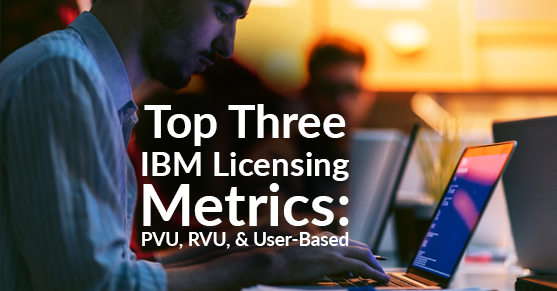IBM software licensing can get complicated. With thousands and thousands of products and licensing possibilities, figuring out the right metrics structure isn’t always the most straightforward process. To help clear up some confusion around a few popular IBM licensing metrics, we wanted to give an account of Processor Value Unit (PVU) Licensing, Resource Value Unit (RVU) Licensing, and User-based Licensing.
Processor Value Unit (PVU) Licensing
PVU licensing refers to how costs are determined for specific IBM software. When you buy a particular software product from IBM, there is a prerequisite amount of PVUs for the processor that it’s being installed on. In other words, the type of processor deployed on your server will determine the cost/amount of PVUs for the license. The technology your company already uses determines the PVU licensing for every given IBM product — and there are thousands of IBM products — which means accurately evaluating the server(s) you’re installing it on is key to proper licensing.
It’s important to note the opportunities for PVU licensing that virtualization has brought to the table. At a fraction of the capacity of your on-premise server, you can delegate a significant portion of your server resources to a virtual machine. However, it does require extra hardware, i.e., tools for measuring the use capacity and which IBM products are being used (as many companies host a variety of IBM products for their daily activities).
Overall, PVU licensing is the most common, or at least widely known, type of licensing metrics for IBM products.
Resource Value Unit (RVU) Licensing
Where PVU licensing has precise parameters, RVU licensing does not. RVU licensing is subject to a variety of stipulations, and deciding on license entitlement can be a long process of procuring and providing information about where and how the software will be used. Most of these contingencies depend on what the actual product is, but often businesses have to find answers to the following:
- How many unique individuals/entities the software tracks?
- How many mobile interactions per month are being processed?
- How many managed activity processors (MAP) cores are in use?
IBM User-based Licensing
The user-based metric refers to a collection of four metrics that revolve around a specific user or several users accessing a product. The needs of your business and your users will typically determine which one to pursue, i.e., one of the following:
- Authorized User-based Metric: This is one of the most common because it assigns an authorized user to one license. Once that user has been assigned, the account is solidified unless the user is permanently replaced.
- Concurrent User-based Metric: This metric is also rather popular as it allows multiple users to access a program/software simultaneously. Many teams need concurrent access, so this option gives the license owner the ability to install the program on multiple computers for however many users.access, this option is a go-to
- Floating User-based Metric: This metric is somewhat tedious as it requires the installation of a license key, which means that anyone wanting to use the software has to get a license key to start their work. As opposed to the Concurrent User-based metric, only one user is allowed access to a program at a time.
- User Value Unit (UVU) Metric: Any IBM software using this metric is licensed based on the number of users, type of users, and the type of product being installed. Users of this license must assess their environment based on the conditions laid out in the License Information documentation provided with said product.
Let’s Connect
Outside of these metrics, IBM licensing is anything but straightforward. Luckily, experts at Software Licensing Pros have a vast knowledge of IBM licensing types, metrics, compliance, and management so our clients can focus on their primary objectives. Whatever your requirements are, we weave through the terms and conditions to provide your business with compliant licensing for your software.
Feel free to reach out to us via the comments below or contact us here for more information.
This post was originally published here.

